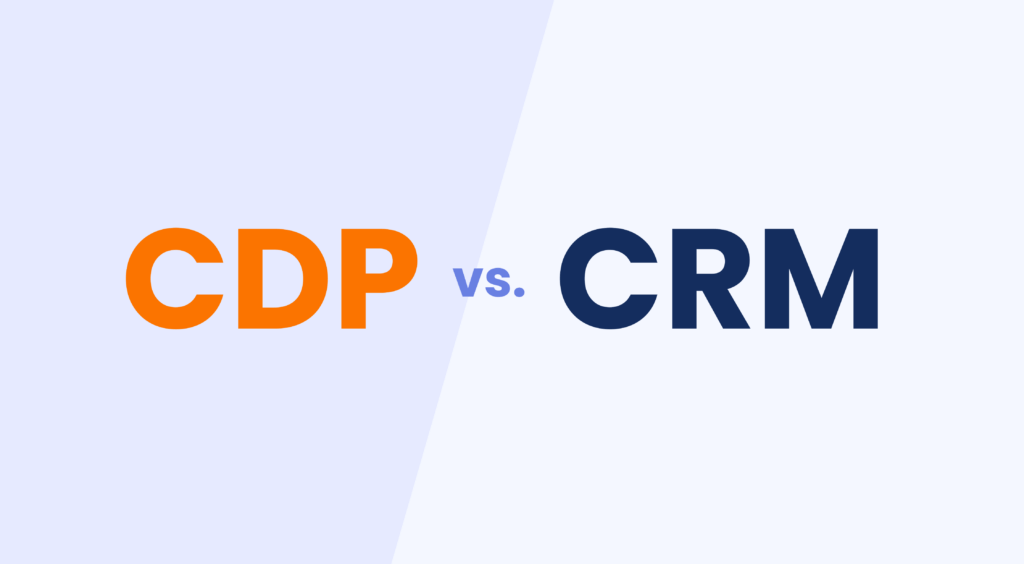
The two most commonly used marketing technologies today are a Customer Data Platform (CDP) and a Customer Relationship Management (CRM) system. Across countries, regions, and industries – most people understand the power of using these marketing tools. However, if we had a penny for every time someone mistook a CDP functionality for that of a CRM, we would have a billion dollars in the bank by now. Whilst, this confusion is understandable, for various reasons we will look at later, it is important that we dispel the misunderstanding. So let’s discuss the key differences between a CDP and CRM that you need to know today.
But first…
Before we dive right in...
Subscribe to our blog today to ensure that you never miss valuable posts such as this one. We are passionate about helping sports organizations deliver a world-class fan experience, because better fan experience means better business. So why not use this opportunity to the fullest?

Why should you know the key differences between a CDP and CRM?
Keeping up with marketing technology can be quite a daunting prospect. Especially when taking into consideration all the “catching” up the sports industry has had to do lately. Our industry was built on a traditional offline and in-person model. And now, almost everything is online. Additionally, working data-driven is no longer a desirable but rather a non-negotiable. Now factor in all the marketing technology out there that you need to keep up with.
Understanding the key differences between a CDP and CRM will help you:

Invest in the right system for the right purpose

Get the most out of the systems that you have already invested in

Achieve optimal efficiency in all your marketing and sales activities
What is a CDP?
A CDP “is a packaged software that creates a persistent, unified customer database that is accessible to other systems.”
What sets a CDP apart from other tools?
- It gives a unified customer database. This is where the magic of a CDP lies in fact. A CDP collects data from multiple touch points, both online and offline, unifies this, and cleans this to give you a 360-degree view of your supporters. You can only satisfy this functionality by using a CDP and not any other tool.
- It’s a packaged software. There are many data collection tools out there so feel free to read more about how these differ from a CDP and why a CDP always emerges as the superior option.
- A CDP then makes all this data available to other systems, including a CRM for example. You can make many integrations with a CDP.
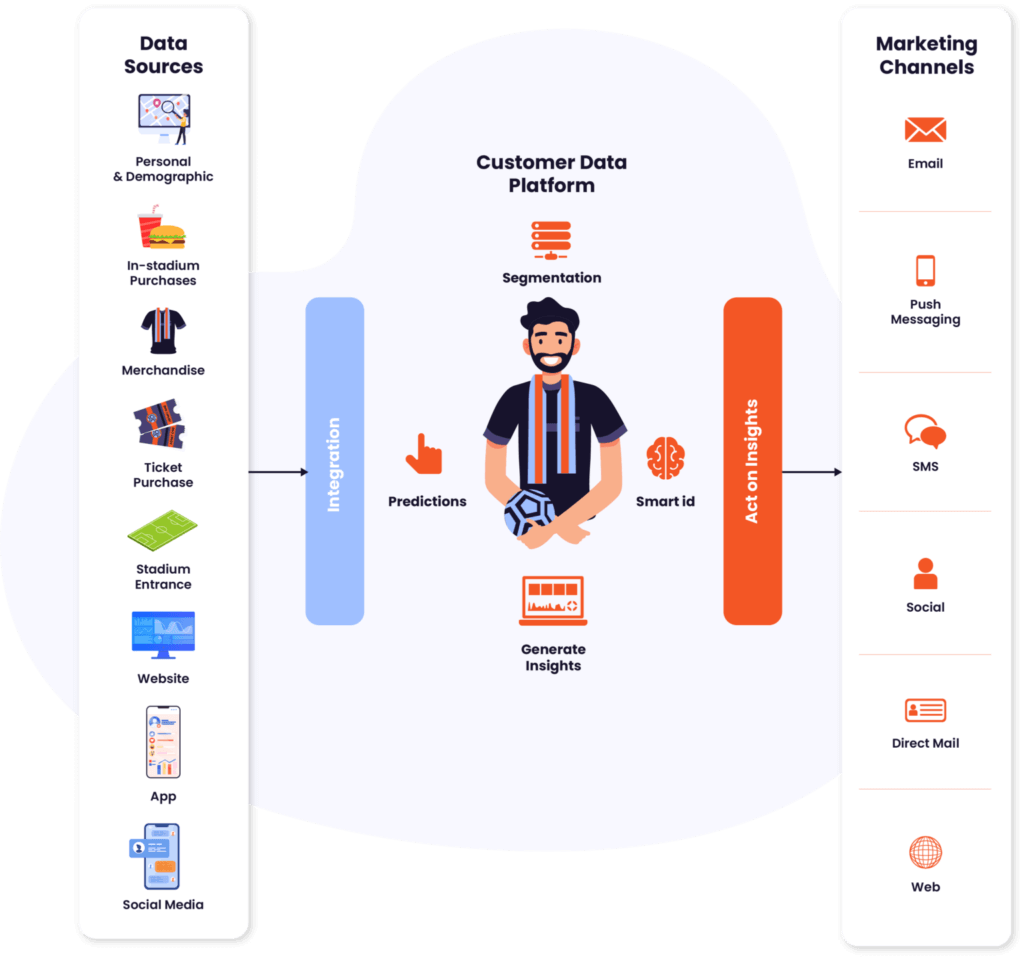
Why this matters, especially for sports organizations
We have written a blog post on why sports organizations need a CDP to grow and thrive that we recommend you read. However, in a nutshell, sports organizations need a CDP because:
- It is the easiest yet most powerful marketing tool out there
- You can leverage and create new revenue opportunities with the CDP
- It helps maximize marketing spend
Do you know the sayings, “what you don’t know won’t hurt you” or “ignorance is bliss”? Well, no one ever uses these phrases when it comes to the bottom line of any organization because knowledge is power. And that’s exactly what a CDP does for you. It gives you ALL the knowledge you could ever need about your supporters.
What is a CRM?
According to Keap, a CRM is “a software system that helps business owners easily track all communications and nurture relationships with their leads and clients. A CRM replaces the multitude of spreadsheets, databases and apps that many businesses patch together to track client data”.
What sets a CRM apart from other tools
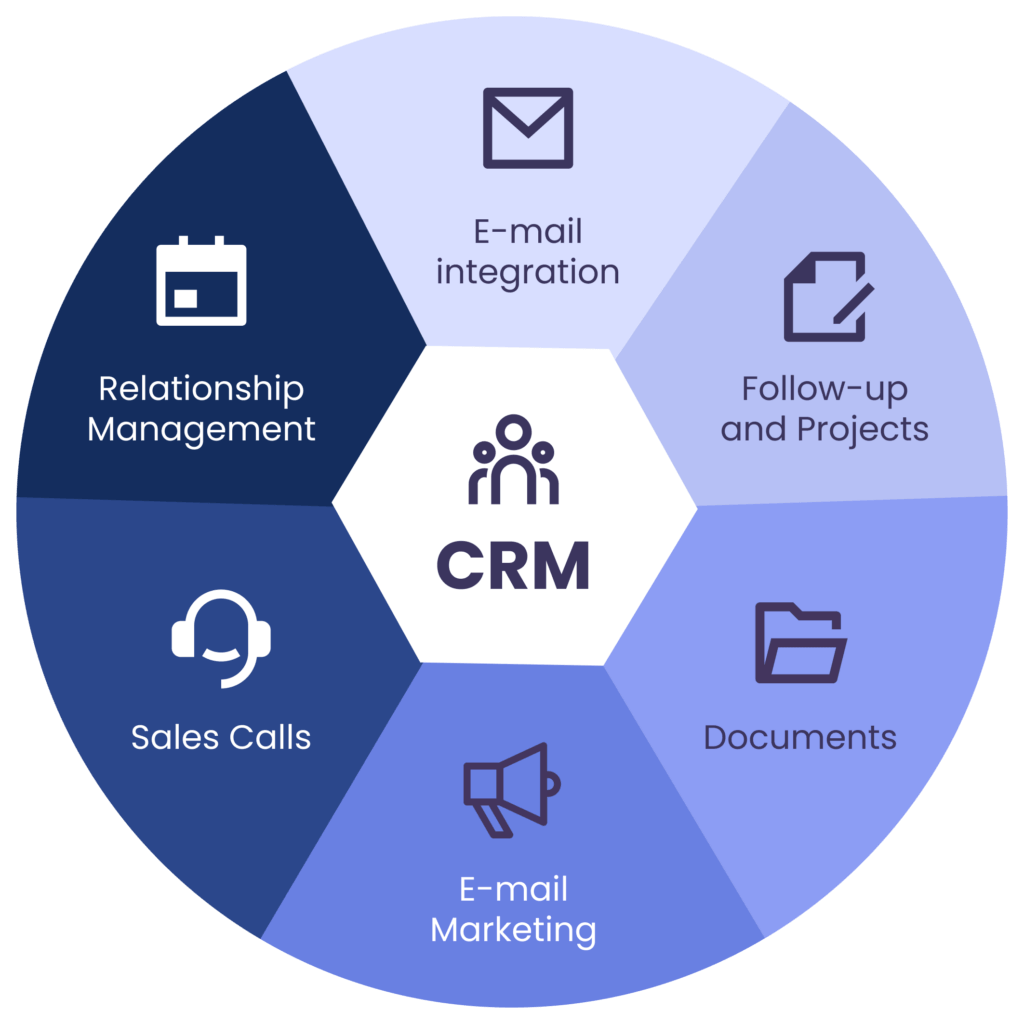
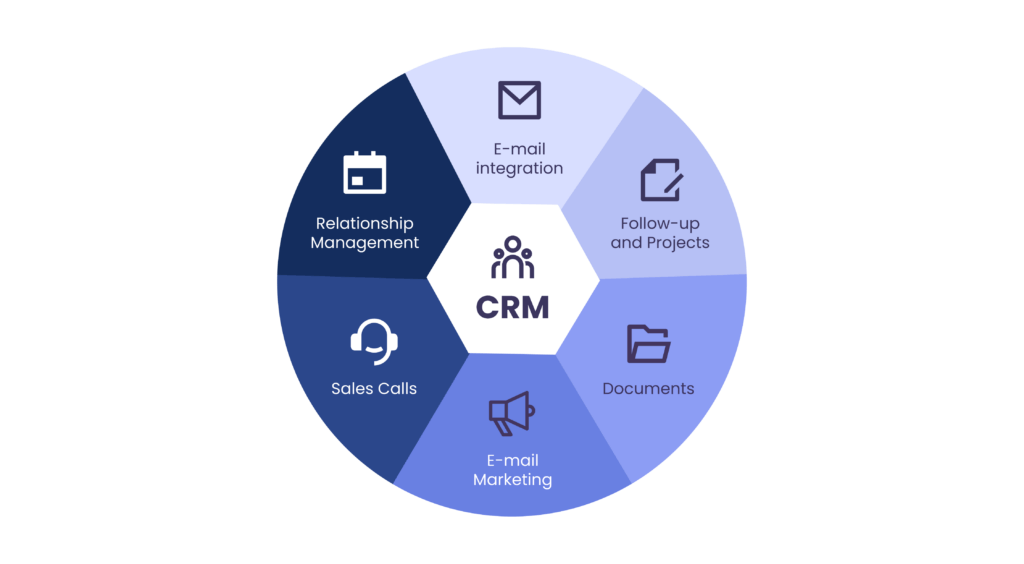
Source: Techpalace
- A CRM stores contact information such as names, addresses, and social media accounts.
- Lead management is yet another reason to use a CRM. You can “manage the process of converting prospects into potential customers (leads) by identifying, scoring, and moving leads through the sales pipeline” Capterra
- Interaction management is also another key functionality of a CRM
Why this matters to sports organizations
Capterra has written an amazing article on 10 CRM features and why you need them. But in a nutshell, sports organizations could benefit from a CRM because it allows for:
- Easy access to supporters’ data
- Streamlined processes through automation
- Actionable insights into business performance and supporter behavior
Now that we have a little snapshot of what these two tools are and their core functionalities, let’s look at what they have in common, before looking at their key differences.
Why do these two often get confused?

Firstly, a CDP and a CRM system are both software

At their core, both a CDP and CRM collect data

Both can be integrated with other systems for seamless day-to-day marketing activities

And you can use both to improve supporter experience

Finally, you can use both tools for segmentation
However, do not make the mistake of thinking that you can use one instead of the other. Because, even though the two systems have a bit in common, they are vastly different from each.
So, let’s look at…
The key differences between a CDP and CRM
Primary functions: data collection (CDP) vs relationship management (CRM)
Number one on our list of key differences between a CDP and CRM is primary functions. The names of both provide us with clues of their primary functions. A Customer Data Platform’s primary function is to collect, store and unify customer data. Or in our case, supporter data. Whilst the primary function of a Customer Relationship Management system (CRM) is to manage your relationships with your customers. So while both systems collect data, it would be for different functions. Moreover, because the primary function of a CDP is to collect and unify data, a CDP’s data collection functionality is vastly superior to that of a CRM.
Primary purpose: supporter behavior (CDP) vs supporter facing interactions (CRM)
Another one of the key differences between a CDP and CRM lies in the tools’ primary purpose. A CDP is designed to help you understand each step a supporter has taken when interacting with your organization. From attending an event of yours to buying season tickets and/or merchandise, a CDP can track all of this. Whereas a CRM is designed to organize and manage supporter-facing interactions with your team.
This leads us to …
Intended end-user: marketing (CDP) vs sales (CRM)
Third on the key differences between a CDP and CRM is the intended end-user. Understanding supporter behavior is a high priority for the marketing team whilst understanding supporter-facing interactions would be one of the sales team’s highest priorities. As such, a CDP was designed with the marketer as the end-user and a CRM with the sales team as the end-users.
Method of data collection: both automatic and manual (CDP) vs manual (CRM)
CDPs collect data both automatically and manually (via file uploads) whilst CRMs collect data manually. Remember the main function of a CDP is to collect data – so this needs to be automated in order for it to be effective. Especially since supporters will have various touch points with your organization. For example, your website, point of sale system (POS), ticketing system, in-stadium games, in-stadium purchases, mobile app, and so on. Because this method of data collection is automated, the data stored in a CDP is very easy to export and share with other systems. Additionally, a CDP also supports manual file data collection. Making it completely flexible enough to fit any organization’s needs.
Whenever the sales team uses a CRM, it’s always to document interactions with specific supporters and customers. Therefore, a CRM’s data collection method is manual. Additionally, this data is only meant to be used in the CRM. Effectively making the data collected within, difficult to export. Except, the CRM can be integrated with a CDP to make the data within a CRM that much more reliable. So, the CDP helps increase the power and effectiveness of a CRM.
GDPR and privacy regulation compliance: compliant by design (CDP) vs not always compliant (CRM)
GDPR and privacy regulation compliance is one of the hottest topics right now. CDPs are by default GDPR compliant. That’s because CDPs primarily store first-party data. That is, data that the supporter willingly shares with your organization. And whatever preferences they give when it comes to handling their data, the CDP will honor. Thus making a CDP one of the most GDPR and privacy regulation compliant systems out there.
However, you cannot say the same about a CRM. Many CRM providers have had to redesign their systems to make them more GDPR compliant.
Should you invest in one over the other?
Honestly, CDPs and CRMs are most often used in tandem. That’s because not only do they serve different purposes but they also serve complementary ones too. For example, integrating your CRM to your CDP, makes a CRM system’s data easy to share. Thus increasing its power and effectiveness. So asking whether to invest in one over the other is like asking if you should focus on collecting supporter data or on managing your relationships with your supporters. The answer to that question would be both.
CDP VS CRM
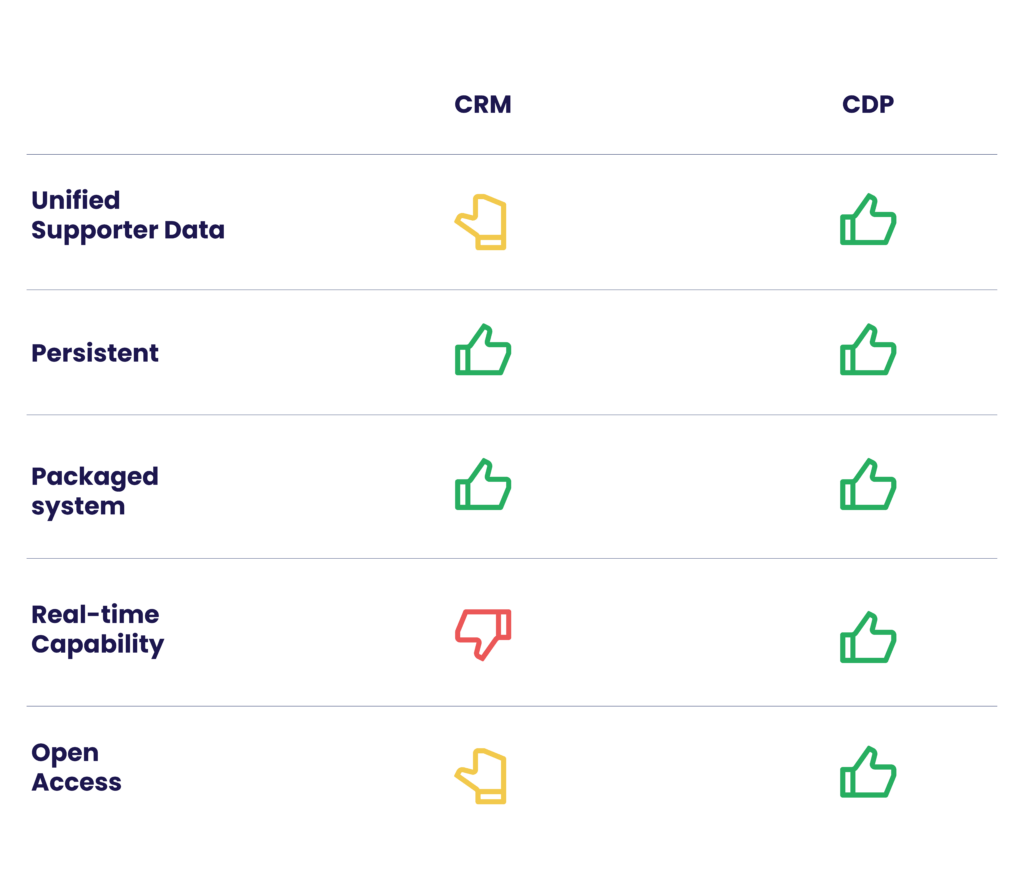
Source: CDP institute (adapted) Jordie van Rijn
However, bear in mind that you need data to communicate and manage your relationship with your supporters. You need to have a holistic view of who they are and what they like. And you can only do this with a CDP. Furthermore, the CDP proves superior to the CRM in other areas such as real-time capability and open access. That is, with a CDP’s automatic data collection, every time a supporter interacts with your organization, the data on that supporter is updated – in real time. So you never have to rely on obsolete data ever again. Additionally, because of the open access, that is, data in the CDP being available to anyone in the organization that might need it, you never have to work in silos again.
CONCLUSION
So in a nutshell, a CDP is essential for sports organizations because it helps the entire organization get an up-to-date wholistic view on supporters at all times. Thus enabling the entire organization to make data-driven decisions that can be monitored and reapplied consistently for more growth and success.
Since CDPs collects data and enrich it and make it available to other systems, we would recommend investing in one anyway. The difference between an organization powering all their marketing strategies with a CDP versus just using a CRM is way too vast. You cannot develop good relationships or manage your relationship with your supporters well (the primary purpose of a CRM) without first knowing who they are. Nor can you sustainability power your organization with only manual data collection. Well, not if you want to grow anyway. Speaking of which, make sure you read our Why sports organizations need a CDP to grow and thrive blog post if you are still in doubt.
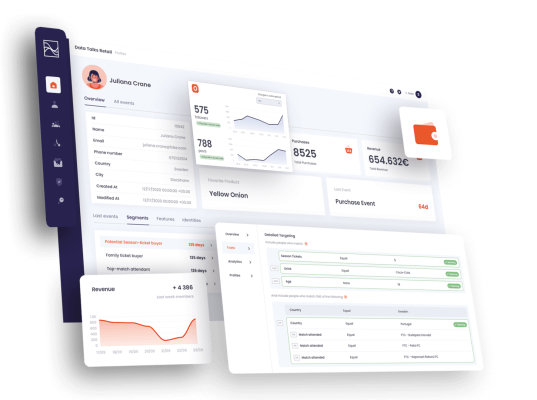
Leave a Reply